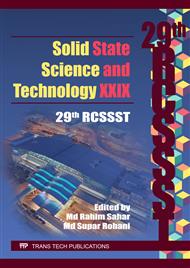p.138
p.143
p.148
p.155
p.160
p.165
p.172
p.177
p.181
First Principles Study on Phonon Energy in SiO2 Glass with the Incorporation of Al2O3
Abstract:
The aim of this study is to investigate the incorporation of Al2O3 in SiO2 glass with emphasis on reducing the phonon energy in the SiO2 matrix. Pure SiO2 glass has very high phonon energy of about 1100 cm-1, while Al2O3 has 780 cm-1. By incorporating Al2O3 into SiO2 glass structure, the relative phonon energy of the SiO2 matrix is expected to reduce. However, the composition of Al2O3 has been limited to a desired amount so as not to perturb other properties of SiO2, such as optical absorption. The Infrared (IR) spectra for a portion of SiO2 glass with the Al dopants were simulated at different molar ratio of the composition using Molecular Mechanic and Density Functional Theory (DFT). The Al2O3-SiO2 structures show a significant change in the simulated IR spectra compared to pure SiO2 glass. The Al2O3-SiO2 structures in the present work were constructed by replacing some Si atoms with Al atoms in the host lattice of SiO2 glass. In addition, some O atoms were removed from SiO2 host lattice to get the correct chemical balance. With increasing of Al2O3 content, the relative intensity of ~1100 cm-1 band associated with the asymmetrical O-Si-O/Si-O stretching vibrations is decreased. The decreasing in relative intensity of the IR spectra demonstrates that Al dopants are forming – [Al-O-Si] – linkages in the structure.
Info:
Periodical:
Pages:
160-164
Citation:
Online since:
October 2017
Keywords:
Price:
Сopyright:
© 2017 Trans Tech Publications Ltd. All Rights Reserved
Share:
Citation:


